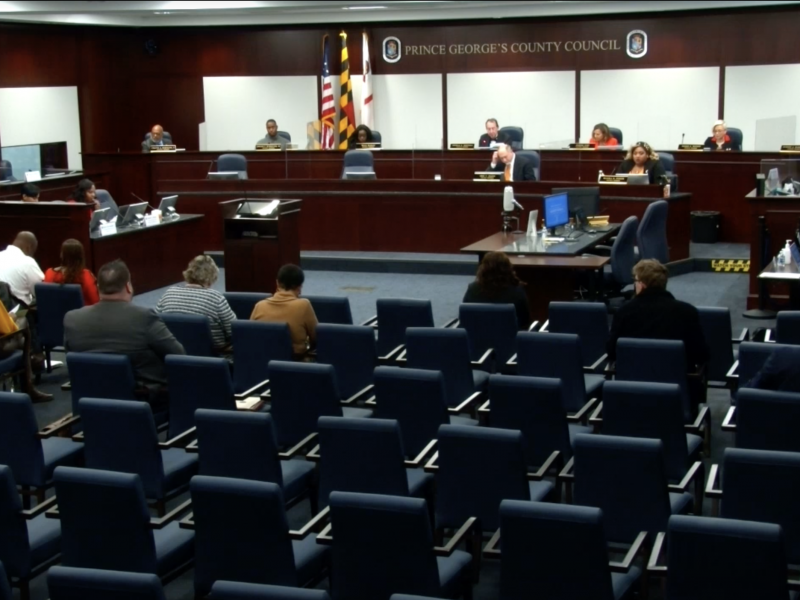Para leer este artículo en español, haga clic aquí.
Amid masked faces, plenty of hand sanitizer and a scatter of QR codes, a feeling of excitement filled the halls of Eleanor Roosevelt High School. Like other counties in Maryland, the Prince George’s County Public Schools system is making a full return to in-person learning.
Students hugged each other, and some had face-to-face conversations with peers and teachers for the first time in over a year. Experiencing this was heartening to high school junior Alvaro Ceron-Ruiz.
“It gives some positivity to the day, to the whole situation,” Ceron-Ruiz said.
The ongoing coronavirus pandemic continues to impact Prince George’s County as the positivity rate remains around 5.4 percent and an indoor mask mandate remains enforced. Currently, the school system has various precautions in place: mask requirements for students and staff, at least 3 feet of social distancing, disinfecting at the end of the school day and increased airflow in classrooms.
Last spring, PGCPS turned to a hybrid model of learning. Students had the option of returning to in-person classes, while instruction also remained virtual for those who chose to opt-out of that option.
Though it has required a transition, Ceron-Ruiz said, instruction in the classroom allows for less distractions while learning.
“Learning in person is totally different than being virtual,” Ceron-Ruiz said. “I will say that it definitely has allowed me … to actually focus more.”
At Eleanor Roosevelt High, with a population of over 2,000 students, a return to in-person learning doesn’t come without extra precautions. At lunch, students can choose to sit inside or outside. If they sit inside, students will scan a QR code at their table to allow for contact tracing, Ceron-Ruiz said.
[With PGCPS set to return to classrooms in April, some teachers worry for their safety]
If a student were to contract coronavirus, the school would provide written notification to staff and families if there was confirmed or possible exposure. The student would then have to quarantine for at least 10 days and be free of symptoms before going back to class. Unvaccinated individuals who came into contact with this person would have to also quarantine for 10 days.
For Christine Merrill, a stay-at-home mother of five PGCPS students, having her children return to school presents a mix of excitement and anxiety. By last spring, her kids found school to be unenjoyable in its virtual state, and they suffered the effects of isolation from their peers, Merrill said.
So if sending her kids to school this year means a risk of catching the coronavirus something Merrill said she worked hard to fend off for the past year and a half — it is a risk worth taking, she said.
“I’m just walking into this knowing that we’re probably going to get sick,” Merrill said. “It may very well be coronavirus and it could be hard but that’s just what we [have] to do.”
In-person learning also comes with other unique challenges for parents. Merrill’s first-grader has never been into a school building before, and she wanted to wear leggings, Merrill said. But Merrill told her no.
“She does not see any reason why not and this idea of somebody giving her rules that she has to follow, she’s not behind it, and that’s going to be tough,” Merrill said.
[Coronavirus complicates college decisions for Prince George’s County high school seniors]
While Ceron-Ruiz and Merrill both expressed their excitement, fifth grade teacher Annett Jones said she is not 100 percent comfortable with being back in the classroom full-time. On her first day back at Perrywood Elementary in Largo, she recalled having 37 students packed in one class without enough space for social distancing, she said.
Before the pandemic, Jones said her class was never this large.
“Never in my life of 20 plus years of teaching, I’ve ever felt so despondent,” Jones said.
Though she said her roster has decreased to 26 due to the school’s administration making changes to the class size, Jones thinks that the size will go up to 30 by the end of next week as more students decide to come back to the classroom after initially opting for virtual learning in the fall. Additionally, her students are currently unable to get vaccinated, as they’re under the age of 12.
Jones said that the class size may be due to a scarcity of teachers, as she believes many have resigned as a result of COVID-19 concerns and decisions made by the school system.
“Treat us better than that, consider our health,” Jones said. “We have been carrying the wagon.”
In addition to a scarcity of teachers at Jones’ elementary school, the school system has been facing a scarcity of bus drivers, reflecting a national shortage. Last Friday, Ceron-Ruiz said his principal came on the intercom to announce that a bus would not be coming, and for students to make arrangements with their parents to pick them up.
Though Ceron-Ruiz admits that he’s felt a lot of different emotions going back to school, he’s glad to be back.
“I’m hopeful for the school year, [and] I know a lot of students are as well,” Ceron-Ruiz said.



